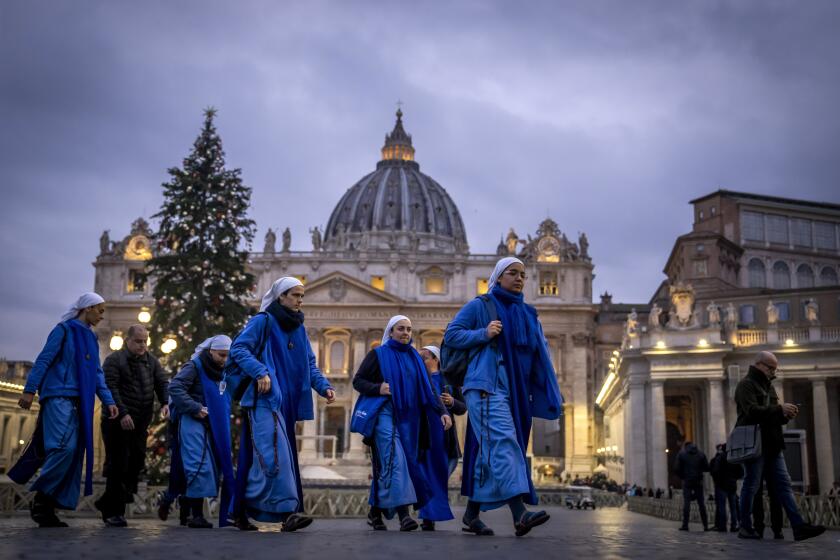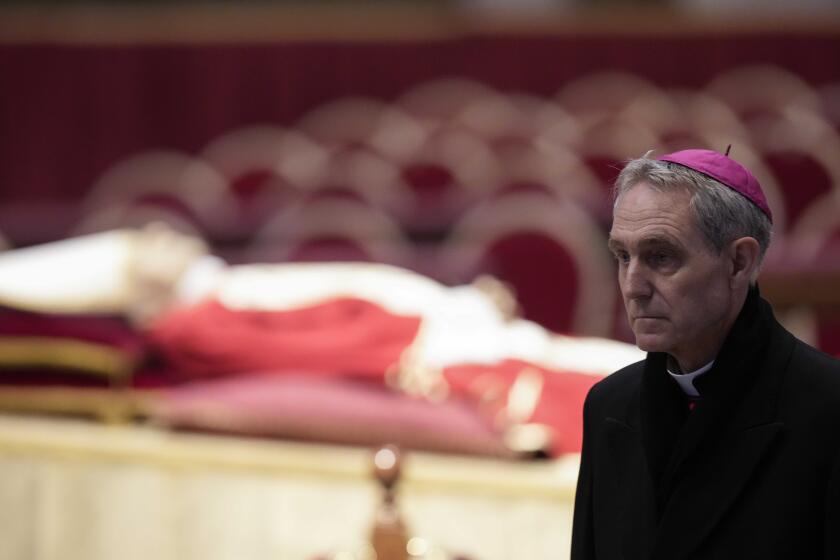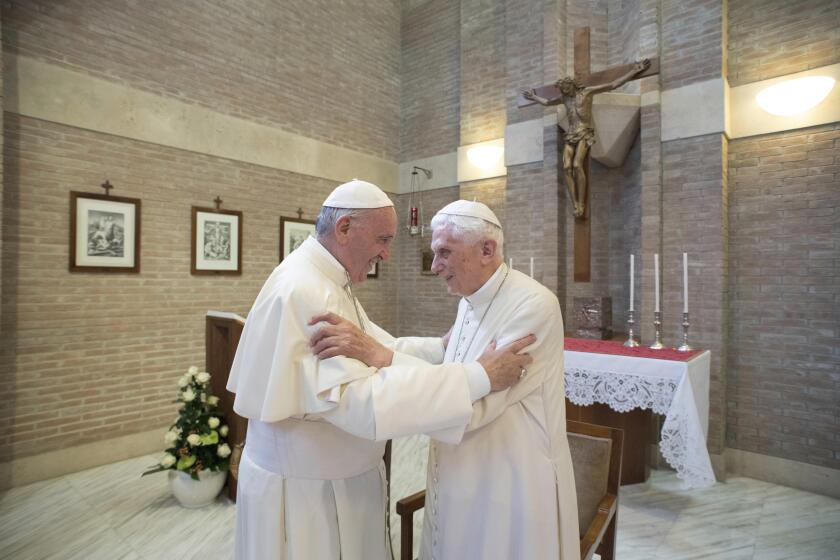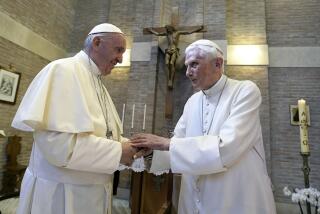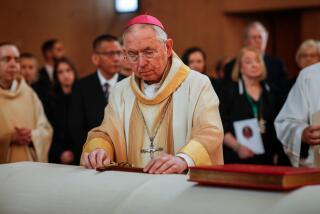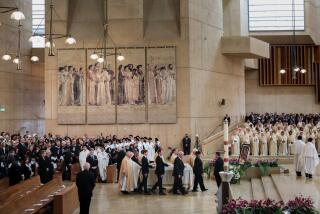Thousands mourn Benedict XVI at a funeral presided over by Pope Francis
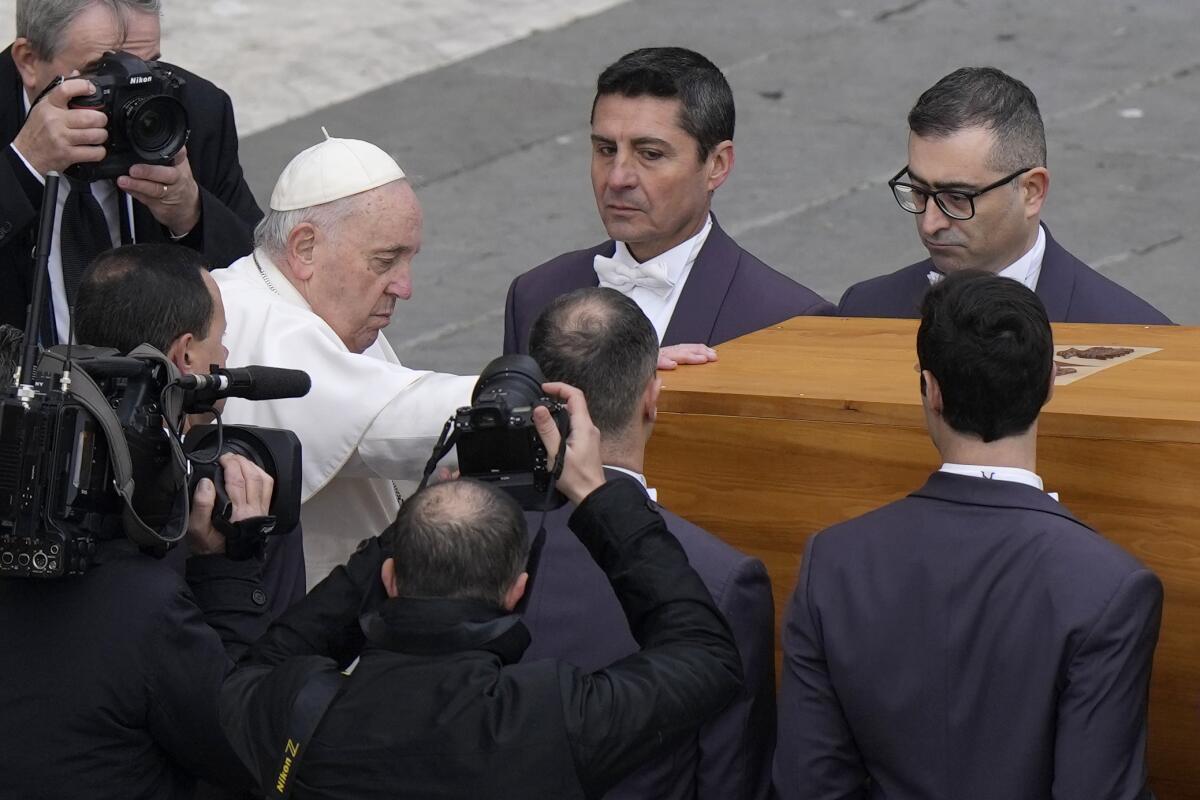
VATICAN CITY — Pope Francis joined tens of thousands of the Roman Catholic faithful Thursday in bidding farewell to Benedict XVI at a rare requiem Mass for a dead pope presided over by a living one, ending an unprecedented decade for the church sparked by Benedict’s decision to retire.
Bells tolled and the crowd applauded as pallbearers emerged from a fog-shrouded St. Peter’s Basilica and placed Benedict’s simple cypress coffin before the altar in the vast square outside. Francis, wearing the crimson vestments typical of papal funerals, opened the service with a prayer and closed it an hour later by solemnly blessing the casket and bowing his head.
In between, Francis made only a fleeting reference to Benedict in his homily, offering a meditation on Christ instead of a eulogy of his predecessor’s legacy before the casket was sealed and entombed in the basilica’s grotto.
Heads of state and royalty, clergy from around the world and thousands of faithful flocked to the ceremony, despite Benedict’s requests for simplicity and official efforts to keep the first funeral for a pope emeritus in modern times low-key.
Many mourners hailed from Benedict’s native Bavaria and wore traditional dress, including boiled wool coats to guard against the morning chill.
“We came to pay homage to Benedict and wanted to be here today to say goodbye,” said Raymond Mainar, who traveled from a small village east of Munich for the funeral. “He was a very good pope.”
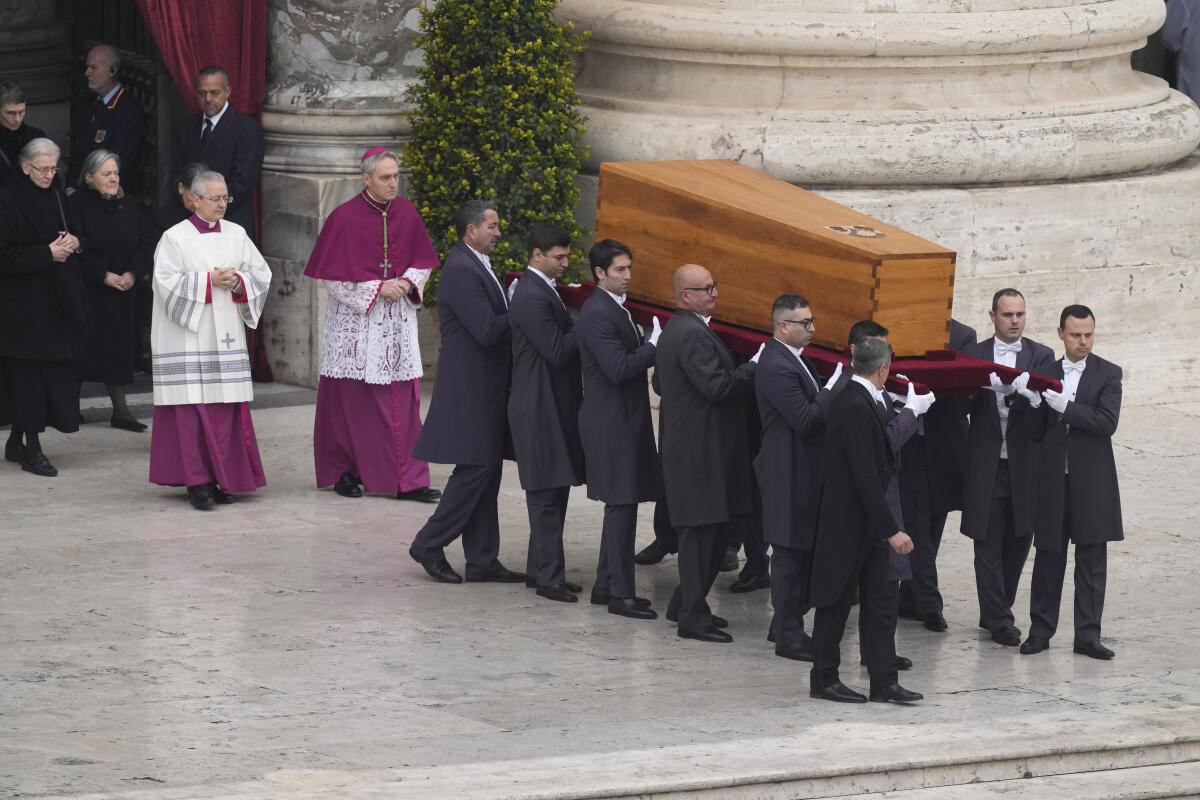
Ignoring exhortations for decorum at the end, some in the crowd held banners or shouted, “Santo subito!” — “Sainthood now!” — echoing the spontaneous chants that erupted during St. John Paul II’s 2005 funeral.
The former Joseph Ratzinger, who died Dec. 31 at age 95, is considered one of the 20th century’s greatest theologians and spent his lifetime upholding church doctrine. But he will go down in history for a singular, revolutionary act that changed the future of the papacy: He retired, the first pope in six centuries to do so.
The Vatican says a written account of the papacy of Pope Emeritus Benedict XVI will be placed alongside his body in his coffin for burial Wednesday.
Pope Francis has praised Benedict’s courage in stepping aside, saying it “opened the door” to other popes doing the same. But few, including Benedict himself, expected his 10-year retirement to last longer than his eight-year papacy, and the prolonged cohabitation of two popes in the Vatican Gardens sparked calls for protocols to guide future resignations.
The Vatican said some 50,000 people attended the Mass, after about 200,000 paid their respects during the three days of public viewing.
Only Italy and Germany were invited to send official delegations, but other heads of state and government took the Vatican up on its offer to come in their “private capacity.” They included several other heads of state, a host of patriarchs and 125 cardinals.
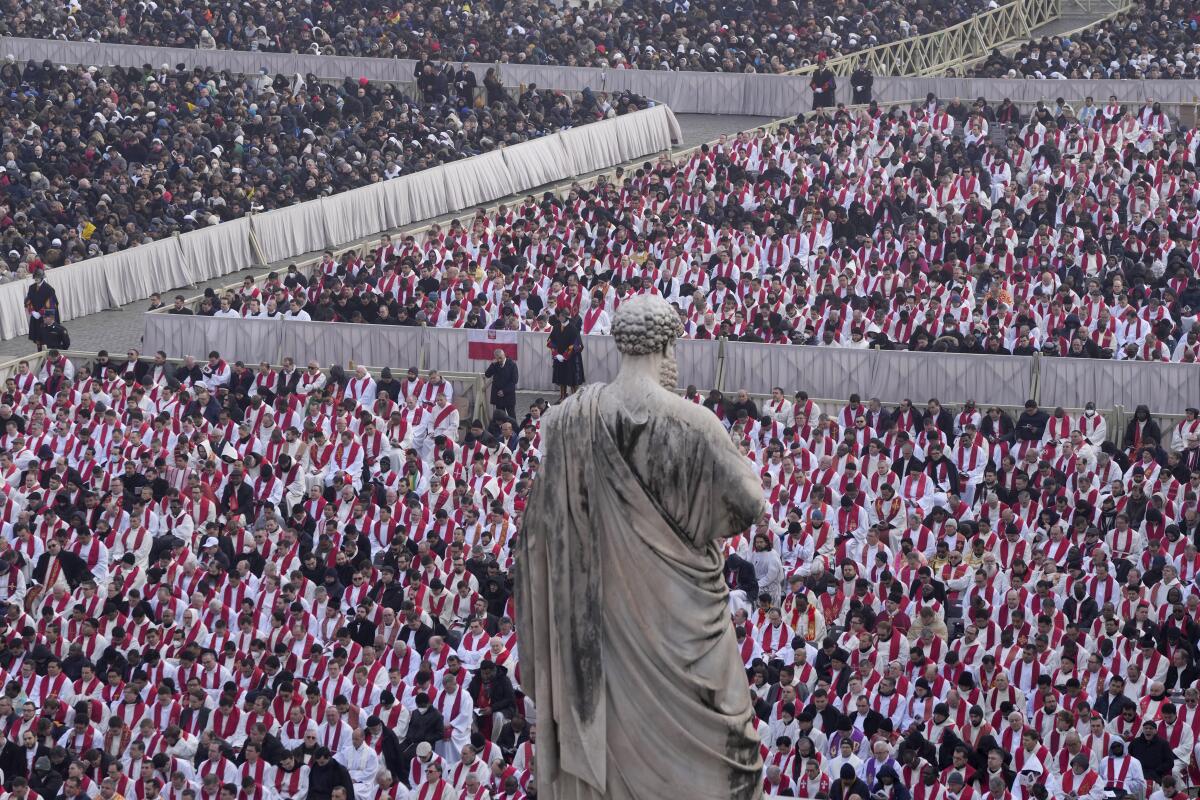
Among those attending was Hong Kong Cardinal Joseph Zen, who was given special court permission to attend the funeral. Zen was detained in May on suspicion of colluding with foreign forces under China’s national security law after he fell afoul of authorities over his participation in a now-silenced democracy movement. His passport was revoked when he was detained.
Benedict’s close confidants were also in attendance, and his longtime secretary, Archbishop Georg Gaenswein, bent down and kissed a book of the Gospels that was left open on the coffin before the ceremony began.
After it ended, the coffin was brought to the basilica grotto, placed first into a zinc casket, sealed and then placed into an oak one.
A choir’s hymn echoed in the crypt as the casket was lowered into the ground, featuring Benedict’s papal coat of arms, a cross and a plaque noting in Latin that it contained his body: “Corpus Benedicti XVI PM.” The “PM” stands for “pontifex maximus,” or “supreme pontiff.”
Pope Emeritus Benedict XVI’s longtime personal secretary has written a tell-all book that is coming out this month.
Matteo Colonna, a 20-year-old seminarian from Teramo, Italy, said he came in part because of the historic nature of the funeral, but also because it had personal resonance for him.
“The first spark of my vocation started under the pontificate of Benedict, but then it became even stronger under Pope Francis,” Colonna said, while sitting in prayer in St. Peter’s Square at dawn. “I see a continuity between these two popes, and the fact that today Francis is celebrating the funeral in Benedict’s memory is a historical event.”
The event was also significant for what it lacked: the feeling of uncertainty that would normally accompany the passing of a pope before a new one is elected.
“Benedict has been the bridge between [St. John Paul II] and Francis,” said Alessandra Aprea, a 56-year-old from Meta di Sorrento, near Naples. “We could not have Francis without him.”
Pope Emeritus Benedict XVI, who will forever be remembered as the first pontiff in 600 years to resign from the job, died Saturday.
Early Thursday, the Vatican released the official history of Benedict’s life, a short document in Latin that was placed in a metal cylinder in his coffin before it was sealed, along with the coins and medallions minted during his papacy and his pallium stoles.
The document gave ample attention to Benedict’s historic resignation and referred to him as “pope emeritus,” citing verbatim the Latin words he uttered Feb. 11, 2013, when he announced he would retire.
The document, known as a “rogito,” or deed, also cited his theological and papal legacy, including his outreach to Anglicans and Jews and his efforts to combat clergy sexual abuse, “continually calling the church to conversion, prayer, penance and purification.”
Francis did not talk about Benedict’s legacy in his homily and uttered his name only once, in the final line, instead delivering a meditation on Jesus’ willingness to entrust himself to God’s will.
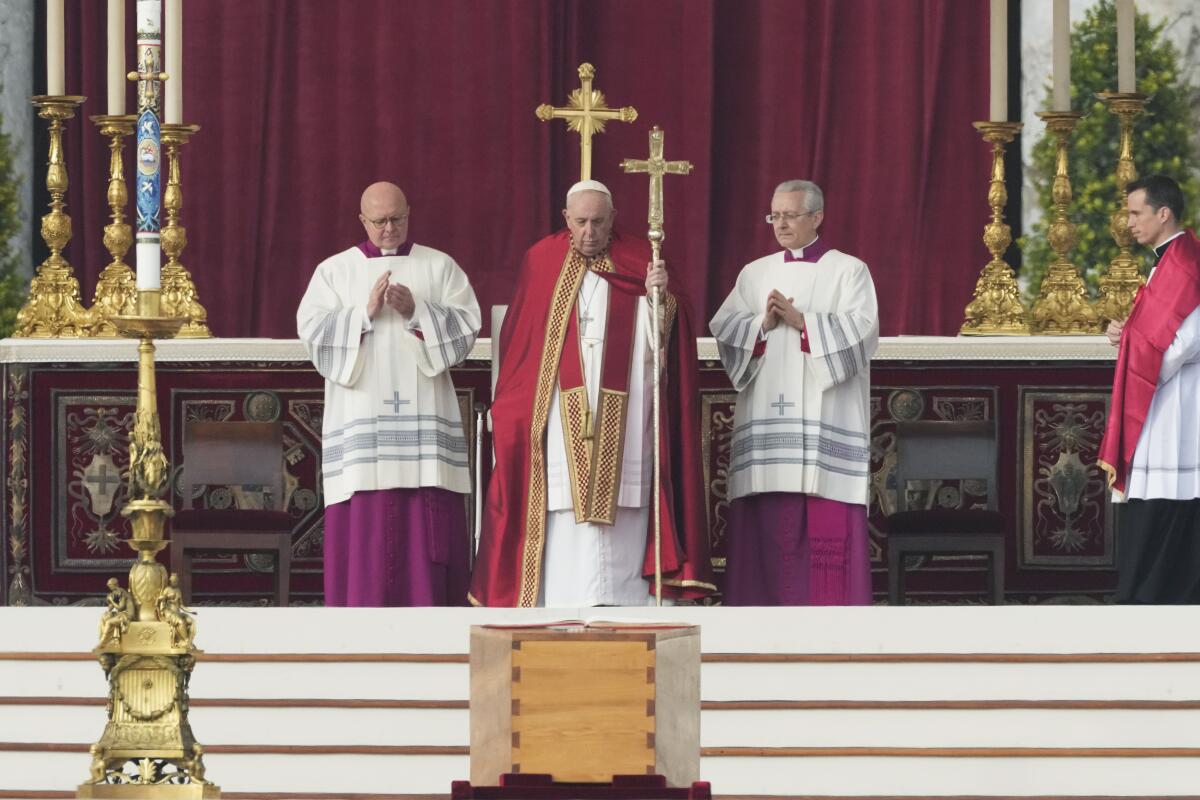
“Holding fast to the Lord’s last words and to the witness of his entire life, we, too, as an ecclesial community, want to follow in his steps and to commend our brother into the hands of the Father,” Francis said at the end.
During St. John Paul II’s quarter-century as pope, Benedict, who was then Cardinal Ratzinger, spearheaded a crackdown on dissent as prefect of the Congregation for the Doctrine of the Faith, taking action against the left-leaning liberation theology that spread in Latin America in the 1970s and against dissenting theologians and nuns who didn’t toe the Vatican’s hard line on matters like sexual morals.
His legacy was marred by the clergy sexual abuse scandal, even though he recognized earlier than most the “filth” of priests who raped children, and laid the groundwork for the Holy See to punish them.
As cardinal and pope, he passed sweeping church legislation that resulted in 848 priests being defrocked from 2004 to 2014, roughly the years of his pontificate, with an additional year on either end. But abuse survivors still held him responsible for the crisis, for failing to sanction any bishop who moved abusers around and refusing to mandate the reporting of sex crimes to police. They identified him as embodying the clerical system that long protected the institution over victims.
News Alerts
Get breaking news, investigations, analysis and more signature journalism from the Los Angeles Times in your inbox.
You may occasionally receive promotional content from the Los Angeles Times.
Mike McDonnell of the U.S. abuse survivor group SNAP said that, while Benedict passed new canon laws, he could have done far more to influence St. John Paul II to take firm action. Referring to Benedict’s nickname as “God’s Rottweiler,” he said: “In our in our view, it was a dog bark without a bite. Certainly he could have done more.”
A group representing German clerical abuse survivors called on German officials attending Benedict’s funeral to demand more action from the Vatican on sexual abuse. Eckiger Tisch asked German leaders to demand that Francis issue a “universal church law” stipulating zero tolerance in dealing with abuse by clergy.
Benedict’s funeral was modeled on the code used for dead popes but with some modifications, given that he was not a reigning pontiff when he died.
While Thursday’s Mass was unusual, it did have some precedent: In 1802, Pope Pius VII presided over the funeral in St. Peter’s of his predecessor, Pius VI, who had died in exile in France in 1799 as a prisoner of Napoleon.
More to Read
Sign up for Essential California
The most important California stories and recommendations in your inbox every morning.
You may occasionally receive promotional content from the Los Angeles Times.
